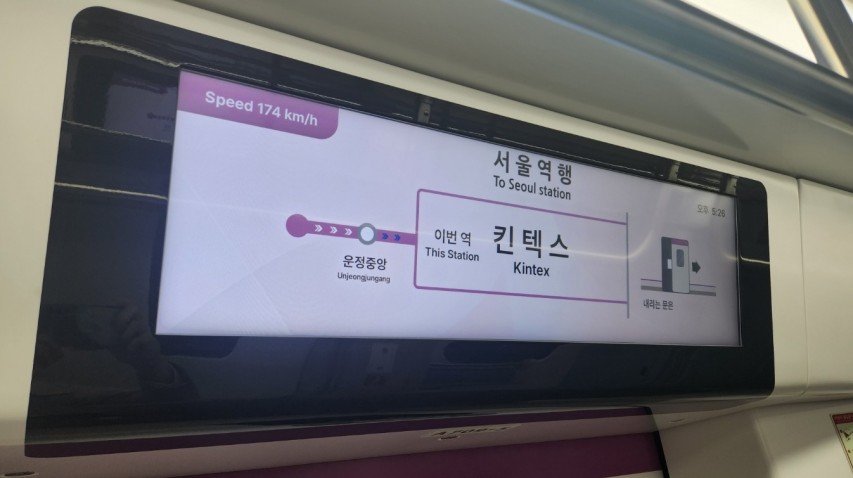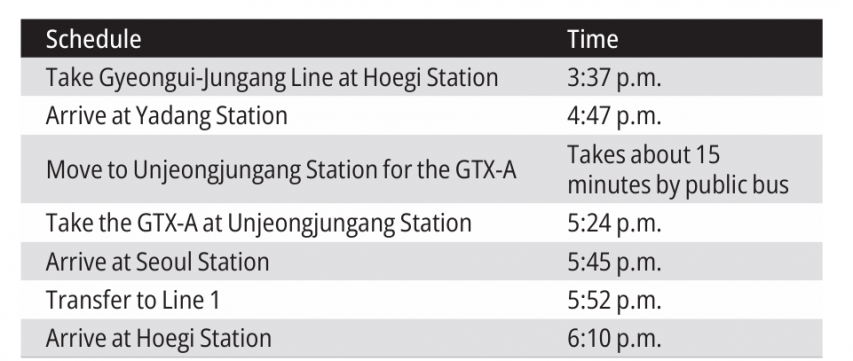[Feature] How Will the New GTX-A Line Affect Daily Life?
The GTX-A display
On December 28, 2024, the section of the Great Train Express (GTX) between Unjeongjungang Station and Seoul Station officially opened, following the earlier opening of the Suseo–Dongtan section in March. This new route dramatically shortens the travel time between the northwestern outskirts of the capital and its city center to about 20 minutes.
According to a 2014 feasibility report by the Korea Development Institute, the outdated and inefficient transit systems prompted the construction of the GTX line. To ensure on-time performance, the system was built with exclusive tracks and platforms.
What Is the GTX?
The GTX is a high-speed commuter rail system aimed at connecting major areas across the Seoul capital area. The system was introduced to meet the increasing demand for efficient long-distance transportation amid rapid suburban development.
A key merit of the GTX is its high speed and compact route. The train runs approximately at 180 kilometers per hour at maximum, with only five stops betweeen Unjeongjungang Station and Seoul Station.
In addition, the line provides convenience through frequent operation. Trains run every 6-7 minutes between 6 a.m. and 9 a.m., and 8–10 minutes even during non-peak hours. The first train departs Unjeongjungang at 5:30 a.m. and the last train from Seoul heading back at 12:38 a.m. the following day.
The GTX vs. Conventional Public Transportation
These advantages reduce travel burdens for daily commuters and Kyung Hee University (KHU) students, who commute between Paju or Goyang and Seoul Campus. To assess the impact on students commuting to the Seoul Campus, a comparison was conducted between traditional public transport and the GTX-A route. On March 28, Friday, a test trip from Hoegi Station— near KHU’s Seoul Campus—to Yadang Station via the Gyeongui-Jungang Line took 70 minutes. From there, a bus ride to Unjeongjungang Station required about 15 minutes.
The return journey using the GTX-A was markedly faster: departing Unjeongjungang Station at 5:24 p.m., arriving at Seoul Station at 5:45 p.m., transferring to Line 1 at 5:52 p.m., and arriving back at Hoegi Station by 6:10 p.m. In total, the return trip took only 46 minutes—a reduction of at least 20 to 30 minutes compared to traditional options.
Schedule and time of the journey
Downsides of the GTX System
While the system brings clear benefits, it also faces challenges. The high fare stands out as a major concern—a single ride from Unjeongjungang to Seoul Station costs 4,450 won, which is more than double a typical subway fare.
Although youth passengers receive a 30% rebate through the K-Pass program, the discounted cost for daily commuting remains burdensome, particularly for university students. Moreover, while week end travel offers a 10% fare discount to destinations like KINTEX Station, the overall cost still remains high compared to existing public transit.
Unlike other subway lines, fare privileges for vulnerable groups are also limited. The GTX-A line only offers 50% discounts for seniors, people with disabilities, or national merit recipients.
Another notable drawback is that the GTX-A line has yet to directly connect the northern and southern parts of Seoul. Until this section is completed in 2028, passengers must transfer to other subway lines.
The newly opened GTX-A line provides KHU students from Paju and Goyang regions with a faster, more reliable commuting option. However, the system faces challenges due to high fares and poorly integrated transfer networks. Once these issues are resolved, the GTX system has the potential to revolutionize public transit across the capital region.
There are no registered comments.
I agree to the collection of personal information. [view]



